| Home |
| Acknowledgments |
| Conventions |
| Glossary |
| Maps |
| References |
| Links |
| Articles |
| Thumbnails |
| Species
list |
| Family |
| Next
species |
Additional Photos
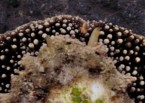
detail

pale brown
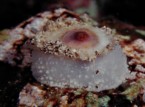
young
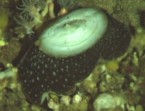
deep water
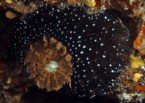
in cave
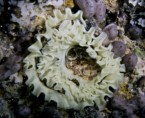
egg mass

Umbraculum sp. #2

| Maximum size: about 127 mm
(Hoover, 2006). Identification: This is a large species with a broad, cap-shaped external shell covering the center of the notum. The mantle is covered with large, conical tubercles and its color varies from white (in small juveniles) through pale brown to dark brown, usually with contrasting cream pigment of the tips of the tubercles. Very young animals may have less well developed tubercles than adults. Shells of shallow water animals are usually overgrown with algae but remnants of a hairy periostracum may be present around their margins. Its shell is more heavily calcified than the shell of Umbraculum sp. #1. Natural history: Umbraculum sp. #2 is a moderately rare nocturnal species found in moderately exposed to highly exposed rocky habitats. It occurs in tide pools and to depths of at least 162 m (532 ft). The record depth is based on photographs taken from HURL submersibles. It feeds on sponges and lays a frilly, cream egg mass (although the color of the egg mass may turn out to be variable). (Note 1) Distribution: Big Island, Maui, Oahu and Midway: perhaps, known from the western Pacific and South Africa? (Note 2) Taxonomic notes: This species is illustrated as Umbraculum sinicum (Gmelin, 1791) in Kay, 1979 and Johnson, 1982 as well as Umbraculum umbraculum in Hoover, 1998 & 2006. It's referred to as the "umbrella shell" by Kay and the "umbrella slug" by Hoover. In both Kay and Hoover, however, the text implies that it's being lumped with Umbraculum sp. #1 and Umbraculum sp. #3. The illustration of Umbraculum sinicum in Edmondson, 1946 also appears to be of this species. It may have been first reported from Hawaii in Eydoux & Souleyet, 1852 (as Umbrella indica). The shells labelled U. sinicum in Morris, 1974 and Tinker, 1958 may be this species but their assignment is ambiguous. Photo: CP: 94 mm, brown; found by student; tide pool, Napili Bay, Maui; Sept. 8, 1995. Observations and comments: Note 1: The one egg mass we've seen associated with this species was white but related West Pacific animals have been photographed laying (or in association with) egg masses ranging from white to peach to yellow, perhaps reflecting differences in diet. Note 2: This species appears to be closest to populations of Umbraculum from the Western Pacific and South Africa. The Western Pacific population has a variable background color with tubercles that lack cream tips but have darker pigment around their bases. In structure, its tubercles are closer to those of the sympatric population of Umbraculum sp. #3 making it more difficult to separate the two (without reference to color) than in Hawaii. It's possible that Umbraculum sp. #2 will ultimately fall within the range of variation of the Western Pacific population. However, its smaller tubercles, lack of variation in background color and the presence of cream tips on its tubercles suggest that it's had a substantial period of isolation and support the possibility that it's a regional endemic. The South African population may or may not represent a third species in the lineage. |
| Thumbnails |
Species
list |
Family | Next species | Top |